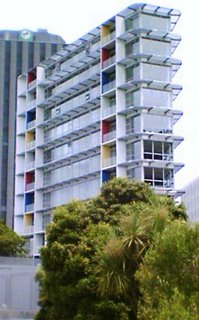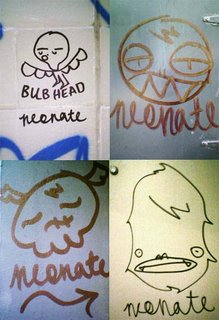First of all, thanks to all of the blogorati who have responded to my call for a
BlogHooley (or "Working Bloggers' Cocktail and Literary Society" as Hadyn has
christened it). Here are the gory details, as worked out through a shining example of collective decision-making:
- Boulôt (15 Blair St)
- Tomorrow night (Friday 9th December)
- From about 6pm (I'll get there by 6 to grab a table, since it looks like there'll be about 10 of us: let me know if you'll be much later).
- The agenda will include, but may not be limited to: eating, drinking, talking about blogging, talking about interesting things, and ogling the bar staff.
- If the mood takes us, we may progress from there to other venues in search of taste sensations and ill-gotten wisdom.
It may not have escaped your attention that Wellington bloggers seem
obsessed with drinking. That should not come as a surprise, since the wheels of urban life need frequent and copious lubrication. Cocktails seem to be the drink of choice for many (
Stephen,
Kate,
Jo), so it's just as well that in most of Wellington, you're
never far from a decent martini. But there are other ways to slake your thirst in this burg, so here's a quick look at some of the options.
WineFor a while it was looking like the wine bar was an endangered species in Wellington, a relic of the expense-account 80s. Only
Beaujolais and
Bouquet Garni survived, and as it became the norm for bars to offer a decent selection of wine by the glass, the idea of a special kind of bar devoted to wine seemed quaint.
Not any more.
Arbitrageur and
Vivo both have a serious (some would say obsessive) approach to wine, and damn good food.
Arbitrageur is lighter, more spacious and arguably quieter, and it officially has
the best wine list in the country.
Vivo is
no slouch either, and while
Beaujolais has the true London connection (I believe it was once owned by
Don Hewitson, whose
Cork & Bottle is the one redeeming feature of Leicester Square),
Vivo's brick walls and buzzing atmosphere makes it feel like it belongs in a basement somewhere in the Square Mile.
Oh, and am I the only one who really misses CO
2? How can we be a
real city without a Champagne bar?
I don't buy wine from retailers very often these days, and if I do it's usually something simple and off-dry to take to a BYO curry house, so I may not be the best authority on that sector (Salient has
a good round up). I've raved before about
Wineseeker, but
Rumbles is a treasure trove and an institution, and
Truffle also has a great selection of (mostly) European goodies. Though I'm not as much of a wine snob as I used to be, I still enjoy the rantings of those who are, especially when they are as entertainingly opinionated as the blog
Screwcaps.
BeerNot having drunk beer for long, I can't do much more than point out the obvious here (
Leuven, the
Brewery Bar and the
Malthouse). For a number of reasons, the Brewery Bar is not my favourite place, but it's fantastic to have some distinctive Wellington beers brewed on the premises. It's a step towards the German attitude, where every city has a distinctive style of beer, and even within a city, every brewhouse makes its own version with its own characteristics.
As Barthes would tell you, one's choice of drink is never purely about flavour or nutrition: it is also a semiotic act that, intentionally or otherwise, broadcasts a message about your social status and belonging.
Bruce Holloway at realbeer.co.nz has kindly posted a list of
beers and those who drink 'em to help us deconstruct these beery signifiers. I'll let you read the original, but suffice to say I'm glad that I don't drink Ranfurly Draught or Flame beer. It's all centred around local beers and mass-market imports, so my poncy lagerphobic tastes don't even get a look in. And what on earth would he make of people who drink
this stuff? (thanks to Hadyn for that link)
SpiritsAny bar worth its barflies is going to have a comprehensive collection of spirits these days, but
Matterhorn and
Motel both stand out for their impressive top shelves. Some bars, however, choose to specialise it particular forms of hard liquor:
- Gin: Juniper
- Whisk(e)y: The Dubliner
- Tequila: Flying Burrito Brothers and Establishment
- Digestifs (not really spirits, but near enough): Capitol
What have I missed? Are there any rum dens or Cognac lounges that the world should know about?
RTDsSo, you're interested in finding the places that specialise in Ready-To-Drink alcopops? Go: leave now, and never darken my blog again!
On the other hand, it may be wise to learn the locations of these dens of iniquity, so that you can be sure to avoid them. Any of the
toplefters would be a good start, though I am sure that any bar that fits in the bottom left quadrant would we equally ready to sell you a gaudy bottle of sugar, food colouring and bathtub spirits. But the quickest way to spot them is to remember two words: Courtenay Place.
Salient's A-Z kindly helps out by defining the Courtenay Quarter in
TLAs: "RTDs, STIs, VIPs, BYOs and SOBs".
CoffeeThere are times when sobriety and alertness are vital (such as 9am to midday on weekdays), so at these times, coffee is
de rigeur. I'm not planning to start a religious war over who's got the best coffee, partly because I'm a bit of a philistine in that regard (a trim latte with two sugars, thanks). Sure, I refuse to go to
Starbucks or
Gloria Jean's if at all possible, but that's not due to coffee snobbery or even anti-globalisation convictions: they're just so goddamn boring! I'll leave the arguments about where to get decent coffee to
Russell Brown.
I also hardly need to point out the influence of coffee culture upon Wellington's maturity as an urban centre. Karl du Fresne already had a go at that in the Dominion Post a few weeks back, and Ian Athfield points out in today's
Wellingtonian that street cafés provide the vital urban function of joining the public and private realms (tell that to Waterfront Watch!). He quotes another architect: "Coffee's done more for cities in the past 25 years than architecture's done in the past 150".
And indeed, much of Wellington's transformation since the late 80s is due to the growth of café culture. Young people today won't believe it, but when I came to Wellington in 1989,
City Limits (now
Finc) seemd to be the only café open after 5pm (and we lived in a hole in t'middle of t'road). But a previous generation of coffee pioneers did their bit for Wellington's cultural life:
Harry Seresin is one notable example, but it's interesting to read
The Daily Grind, an account of the Wellington café scene from 1920.
That's enough for now: all this blogging is making me thirsty. Oh, and by the way, has anyone figured out the
latest mystery bar yet?
 Mystery bar number 14 proved easier than I expected for a brand new place. It looks like some of you were either keenly watching for what happened to the old Steamboat, or are much more familiar with the views out of Courtenay Place windows than is healthy.
Mystery bar number 14 proved easier than I expected for a brand new place. It looks like some of you were either keenly watching for what happened to the old Steamboat, or are much more familiar with the views out of Courtenay Place windows than is healthy.






















 I've managed to book a table for ten people from 6 until 8 tonight. Sorry for the early timing, but
I've managed to book a table for ten people from 6 until 8 tonight. Sorry for the early timing, but 














